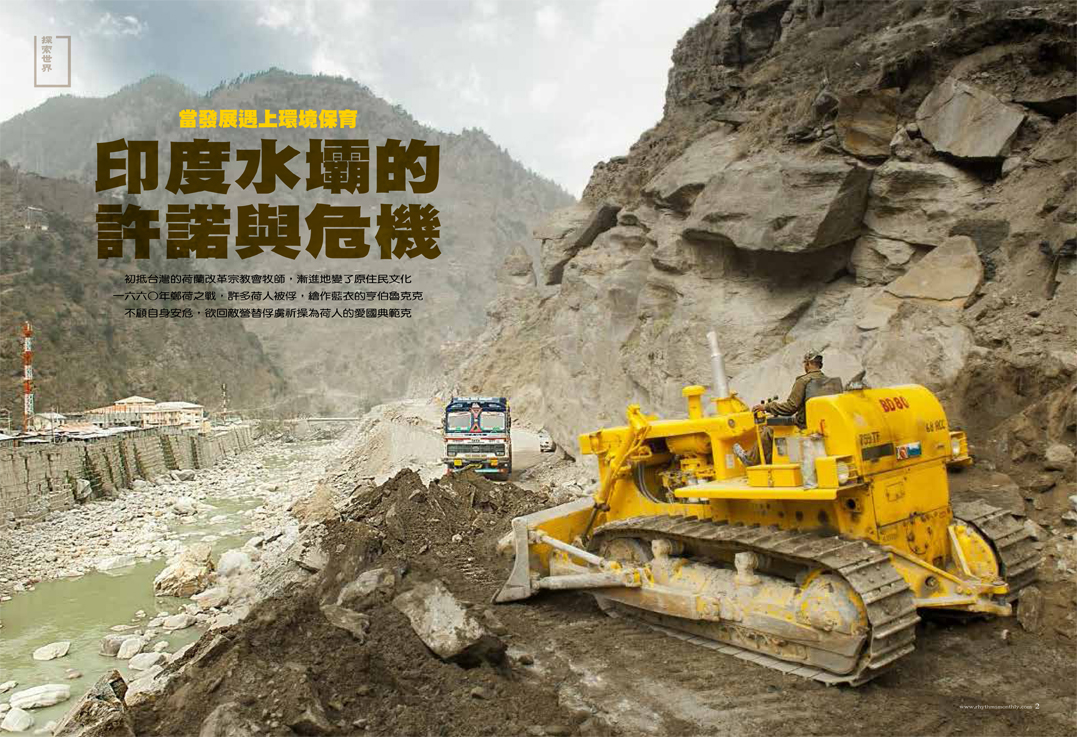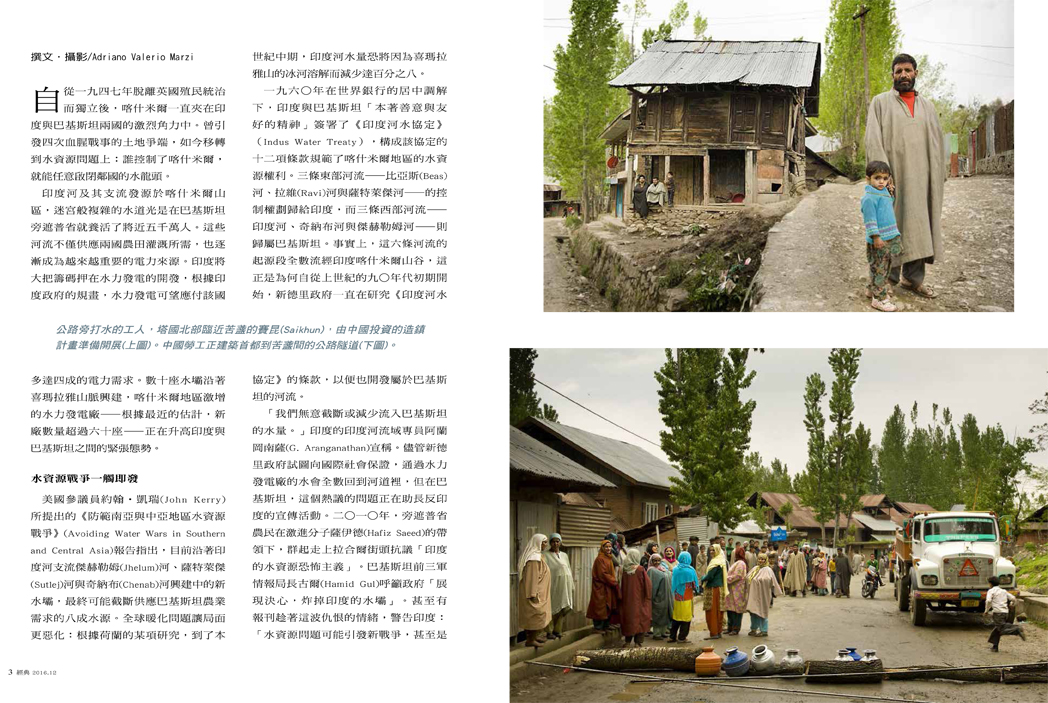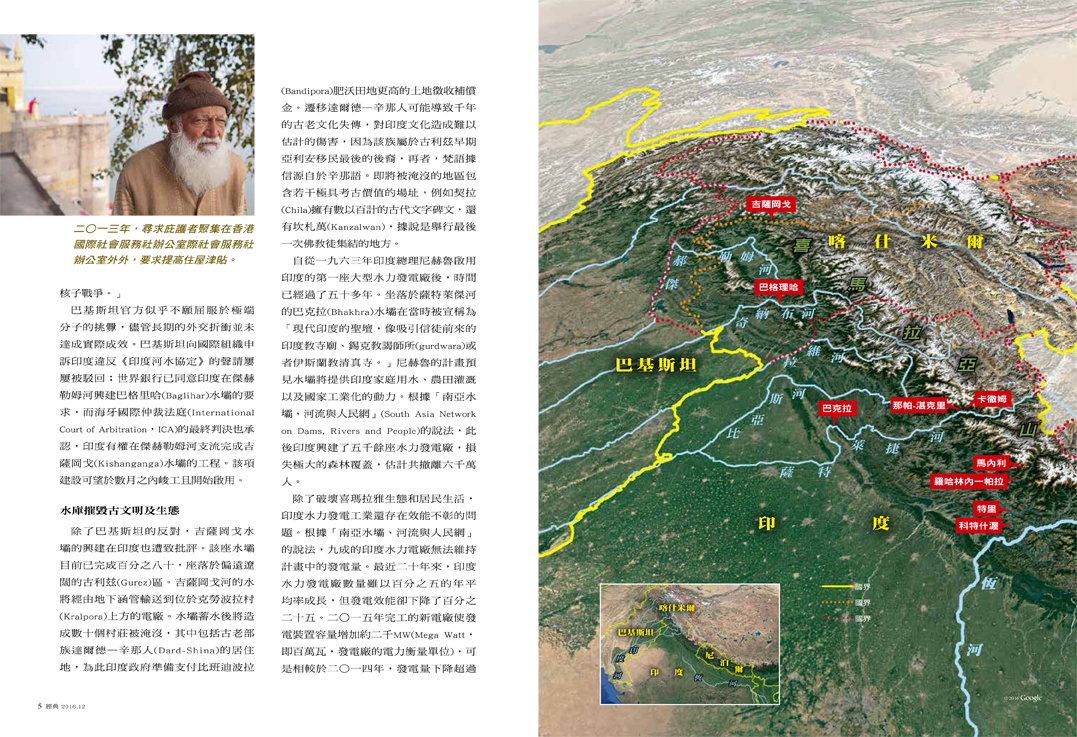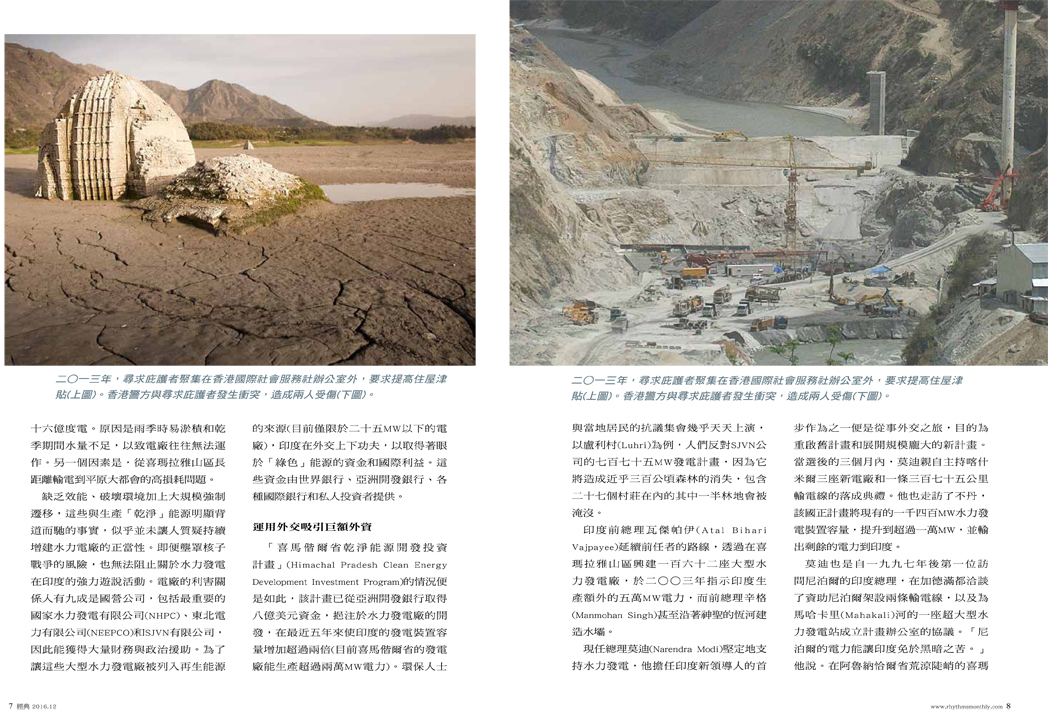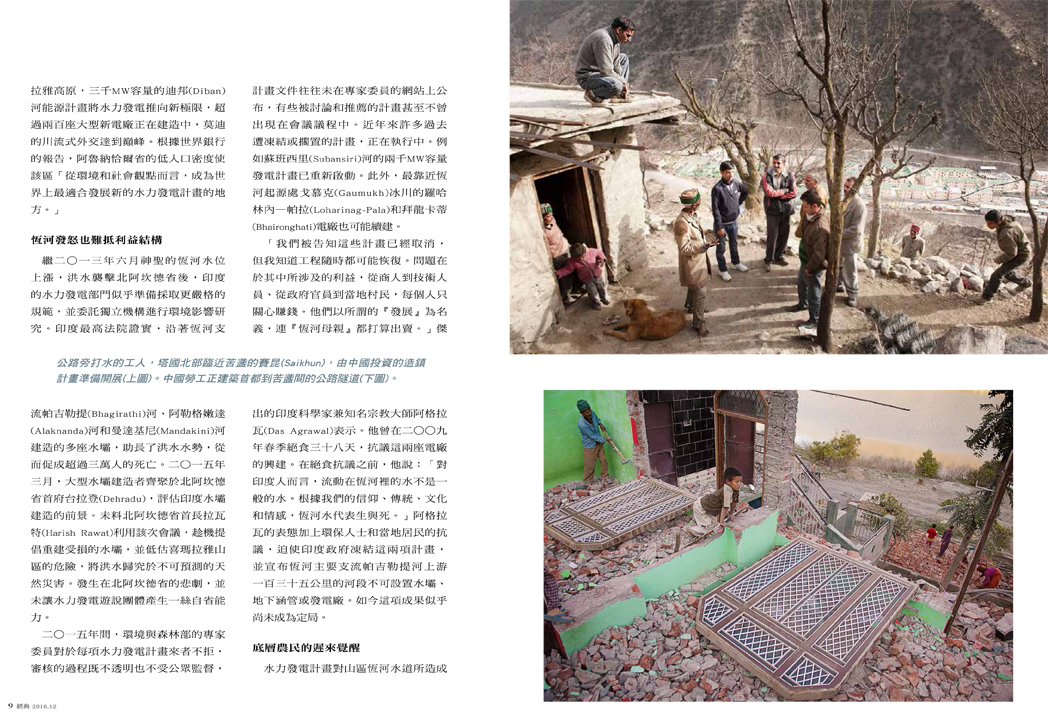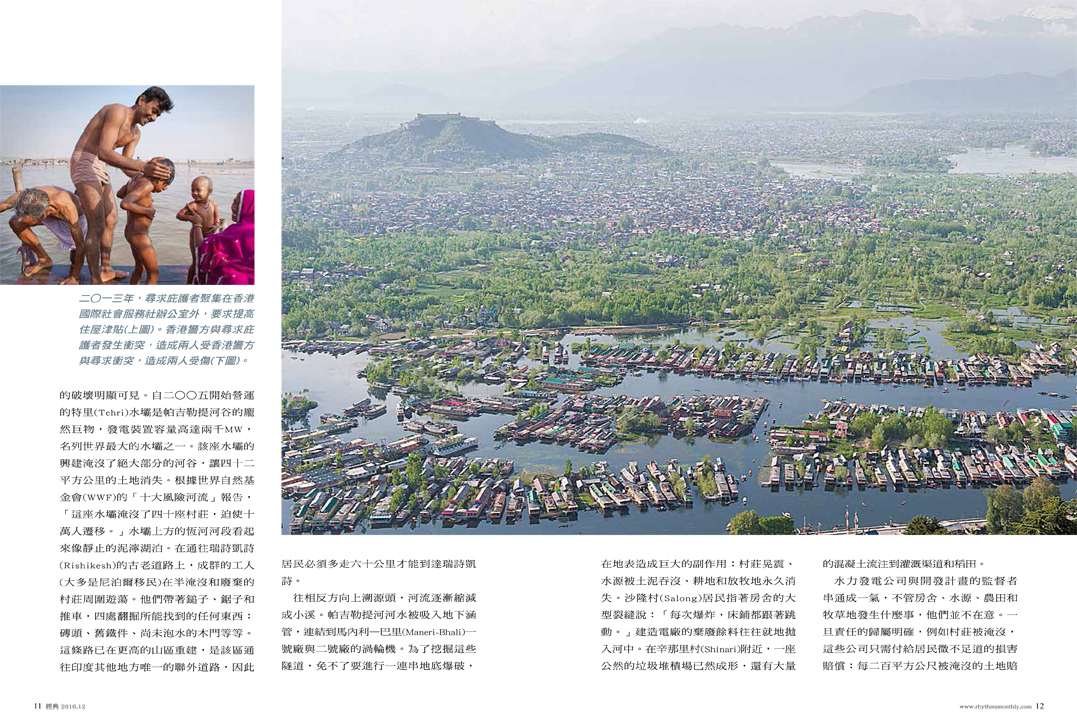Since independence from English colonizers, in 1947, Kashmir has always been fiercely contended between India and Pakistan. Today the dispute about land, which has given rise to four bloody armed campaigns, is shifting to water sources: the country holding control over Kashmir can open and close at will its neighbor’s tap. The Indus river and its tributaries rise in Kashmir mountains, a maze of waterways providing life and work to approx. 50 million people just in Pakistan’s Punjab (literally “five waters”). Not only these waterways are needful to farmland in both countries, but they are becoming more and more important as a power source. India is betting heavily on the development of the hydroelectric sector, which according to Government’s plans is expected to cover up to 40 per cent of the Country’s power needs. Tens of dams have been built along the whole length of Himalaya’s range. Proliferation of water plants in Kashmir – over 60 new plants according to most recent estimates – is raising tensions with Pakistan. As even the “Avoiding Water Wars in Southern and Central Asia” report by US senator John Kerry acknowledges, the new dams under construction at present along Indus tributaries Jhelum, Sutlej and Chenab would eventually make it possible for India to block water supply providing for 80 per cent of Pakistan agriculture needs. Global warming is exasperating this situation: according to a Dutch study, by half of the century Indus delivery is expected to decrease by 8 per cent due to Himalaya’s melting glaciers.
Rights on Kashmir waters are ruled by the12 articles making up the Indus Water Treaty, brokered by World Bank and subscribed in 1960 by India and Pakistan “in spirit of good will and friendship”. Control over the three eastern rivers (the Beas, Ravi and Sutlej) was given to India, while the three western rivers (the Indus, Chenab and Jelhum) pertain to Pakistan. Actually, the initial course of all six rivers flow through Indian Kashmir’s valleys. That’s why, since early Ninety’s New Delhi government is investigating Treaty’s provisions in order to exploit also waters destined to Pakistan. “We do not intend to interrupt or reduce water flow to Pakistan” – declared G. Aranganathan, India’s Commissioner for the Indus Basin. While New Delhi government tries to assure the international community that after passing through hydroelectric plants all of the waters are fed to the rivers’ course, in Pakistan this is a hot question that fuels anti-Indian propaganda. In 2010 Punjab peasants rallied along Lahore streets protesting against “India’s water terrorism”. They were headed by fundamentalist leader Hafiz Saeed, considered the mind of 2008 terroristic attack in Mumbai, on whom a 10 million dollar bounty is placed. Hamid Gul, former Pakistani Secret Services head, rouses government “to show determination and blast India’s dams”. Even some press ride the wave of this sentiments and warn India: “The water question could cause a new war, even a nuclear one”.
Pakistan doesn’t seem to be willing to submit to extremists’ provocations, however diplomatic contacts have so long reached no positive results. Reiterated claiming to international bodies regarding India’s alleged violations of Indus Water Treaty agreements have all been rejected: the World Bank has approved India’s request to building the Baglihar dam on Jelhum river, while the final judgment of the International Court of Arbitration (ICA) in The Hague has recognized India the right to finalize the construction of Kishanganga dam on the homonymous Jhelum’s tributary. This work is expected to be completed and come into operation in next months.
In addition to Pakistan’s protestations, also in India the building of the Kishanganga dam is subject to adverse criticism. The dam, which by now is 80 per cent complete, is located in the far and wide Gurez region, a few kilometers from the Control Line separating India’s Kashmir from Pakistan’s. Kishanganga’s waters will be piped through underground tunnels to the plant built above Kralpora village, 5 kilometer north of Bandipora town, near Wular lake. This will cause the overflowing of tens of villages, among which those where the old Dard-Shina tribe lives, which will thus disappear. As acknowledged also by the Indian government, which in this case is ready to pay a higher compensation for land expropriation than for Bandipora’s more fertile lands, moving Dard-Shina people to the camps organized near Srinagar might cause the disappearing of a thousand-year ancient culture. This would provoke an incommensurable damage to Indian culture, since to this tribe belong the last descendants of the early Gurez settlers, the Aryans; moreover, Sanskrit is believed to derive from shina language. In the area subject to be submerged are comprised sites of high archeological value, such as Chila, where hundreds of epigraphs in ancient languages (Tibetan, Ebraic, Brahmi and Kharoshthi) have been found, or Kanzalwan, said to have hosted the last Buddhist convocation.
More than fifty years have passed since in 1963 Jawaharlal Nehru, historical leader of the Indian independence movement, under the tutelage of Mahatma Gandhi, inaugurated the first huge hydroelectric plant of India: the Bhakhra dam on the Sutlej river was then announced as “an altar of modern India, a site inviting to prayer like an Hindu temple, a Sikh gurdwara or a Muslim mosque”. Nehru’s project envisaged dams would provide water to Indian families, irrigation to farmland and power for the country’s industrialization. Since then, according to South Asia Network on Dams, Rivers and People (Sandrp) more than 5,000 hydroelectric plants were built causing the lost of a huge forest cover and the evacuation of estimated 60million people.
Beyond the damaging caused to Himalaya’s ecosystems and to its people, India’s hydroelectric industry shows a low efficiency level. According to Sandrp, 90 per cent of hydropower plants operating in India do not keep the power generation volumes planned. In the latest 20 years, while the hydroelectric sector in India has grown at an yearly average pace of 5 per cent, the hydropower generation performance has dropped by 25 per cent. Thanks to the new plants completed in 2015 the installed power was increased by approx. 2,000 MW, whereas power generation dropped by more than 1,600 million units (1 unit corresponding to 1 kilowatt/hour) as compared to 2014. Plants are often not in operation both during the monsoon season, due to sediments accumulation, and in the dry season for the water flow scarcity. Another problem is the high level of power loss occurring along the transmission lines due to the big distances from production sites on Himalaya to consumption places in the large Indian planes megalopolis.
Lack of efficiency, environment destruction, massive compulsory evacuation campaigns: nevertheless, the manifest contradictions of this way of producing “clean” energy don’t seem to call into question a continuously growing sector. Not even the risk of a nuclear war can stop the powerful hydroelectric power lobby in India. The sector’s stakeholders are 90 per cent public – among the most important National Hydroelectric Power Corporation (Nhpc), Northeast Electric Power Company(Neepco), Satluy Jal Vidyut Nigam (Sjvnl) – and receive substantial financial and political support. Indian diplomacy is working in order to have the large hydroelectric plants included in the list of renewable power sources (so far limited only to plants below 25 MW) in order to have access to funds and international benefits foreseen for “green” power. Financing is provided by World Bank – which after a number of years standby has started again appropriating funds to the dam business – the Asian Development Bank, various international banks and private investors.
That’s the case of the Himachal Pradesh Clean Energy Development Investment Program, which has obtained from Asian Development Bank an 800 million dollars financing for the development of the hydroelectric sector, which over the last 5 years allowed more than doubling the State installed capacity (today the Himachal plants can generate over 20,000 MW). Protest rallies of environmentalists and local population happen almost every day. At Luhri village, for instance, people struggle against the Sjvnl 775 MW project that would cause the loss of almost 300 hectares forest – half of it, including 27 villages, would be submerged. The company, a joint venture between the Indian and the Regional State governments, is among the major stakeholders in the hydroelectric sector in Himachal, where it built the Nathpa-Jakrhi 1,500 MW giant plant. Beside World Bank, among financers are a European Bank Consortium and private investors such as Impregilo, Siemens, Kaerner, Abb, Suler Escher Wyss, Bhel. Beside this mammoth, which operates also in Nepal and Bhutan, new stakeholders are coming to the scene, such as the Jaypee Group, which has just finalized the Karcham-Wangloo hydroelectric plant, the largest (1,000MW) private hydropower in India, repeatedly convened before the Supreme Court due to local complaints.
In line with his predecessors – Atal Bihari Vajpayee, who in 2003 directed India to generate additional 50,000 MW power through construction of 162 new big hydropower stations on the Himalayas, and Manmohan Singh, who spread dams even along the course of the sacred Ganges river – the new Prime Minister Narendra Modi is a strong supporter of the hydroelectric lobby. Among his first acts as new India’s leader he has been engaged in a diplomatic tour aimed at refloating old projects in standby, inaugurating new unfinished plants, promoting the launch of new gigantic projects. In the three months following his election, the 64-year-old Hindu nationalist inaugurated personally three new hydropower plants and a 375 kilometer transmission line in Kashmir, where he was back in November 2015 to inaugurate the Bagihar II 450 MW plant. He also visited Bhutan, which plans to increase its hydropower from the current installed capacity of 1,400 MW to more than 10,000 MW and export all its surplus electricity to India, to lay foundation stones for the 600 MW Kholongchu Hydel Power Project. Finally, Modi was the first Indian Prime Minister to visit Nepal since 1997: while in Kathmandu, he negotiated an agreement to finance the construction of two transmission lines and to set up a project office for the giant 5,600 MW Pancheshawar Hydropower Station on the Mahakali river. “Nepal can free India of its darkness with its electricity,” he said. Modi’s run-of-the-river diplomacy reached its peak when an advisory committee overruled a previous government decision and approved construction of the 3,000 MW Dibang power project in the wild and steep Himalayan highlands of Arunachal Pradesh, the new frontier of hydroelectricity, where more than 200 new big plants are under construction. Arunachal is one of the “seven sisters”, the seven Northeast States with a special statute, where the greatest part of the remaining indigenous tribes live – according to a World Bank report, the low population density of the region make it “the best place in the world from an environmental and social standpoint to build new hydroelectric projects”.
After the flood that in June 2013 hit Uttarakhand, the Indian State where the sacred Ganges river rises, the Indian hydroelectric sector seemed to be ready to implement a higher degree of regulation and that environment impact studies would be entrusted to independent bodies. As the Indian Supreme Court verified, the many dams built along the Bhagirathi, Alaknanda and Mandakini (the 3 tributaries of Ganges) had reinforced the flood delivery, thus contributing to provoke over 30,000 deaths. In March 2015 builders of big dams met in Dehradun, the capital of Uttarakhand, to evaluate the Country’s dam building prospects. Unexpectedly the State Chief Minister, Harish Rawat, profited of the meeting to promote rebuilding damaged dams and understating Himalayan hazards: “The heavy rain and cloud burst triggered flash floods and landslides, which led to the disaster. Natural calamities happen since time immemorial – wrote Rawat – but people have associated this calamity immensely to the development of hydropower projects. Attributing hydropower development for such loss are more or less a result of lack of awareness and understanding of natural and manmade phenomena and some based on belief and not on scientific reasoning”.
Uttarakhand tragedy, however, did not result in any self-criticism by the hydroelectric lobby: during 2015 the Union Ministry of Environment and Forests’ Expert Appraisal Committee (Eac) on River Valley and Hydropower Projects, the organization which has to give approval for every hydropower projects above 25 MW, had a zero rejection rate. The Eac cleared such a large number of dams and hydropower projects that exceed by far the carrying capacity of the river basins. Moreover, there is little transparency and no public scrutiny: often the project documents are not put up on Eac’ website (as mandated for informed public participation) and some projects are discussed and recommended without ever appearing on the meeting agenda.
Many projects which in latest years had been blocked or suspended are now being carried on. In the Northeast, for instance, work has been recommenced in the 2,000 MW plant built on Subansiri river, just a few kilometers from the point where it joins Brahmaputra river. When construction started in 2005, the 1.6billion dollars Lower Subansiri project was viewed in Delhi as a paramount example of Indian engineering and a jewel of India’s hydropower campaign. The dam was also meant to be the first of three dams on the Subansiri that included a 1,600 MW project in the river’s middle reach, and another 2,000 MW power dam near the headwaters. In December 2011 construction shut thanks to a vibrant public protest. But today Nhpc has started working again.
Also the Loharinag-Pala and Bhaironghati plants, which are the nearest to Gaumukh glacier (literally “cow’s mouth”) where the Ganges rises, might be resumed. “We were told that the projects had been dismissed, but I know that works could be resumed at any time. The problem lies in the financial interests of the people involved in the business. From businessmen to technicians, from government officers to local village people everybody just cares for money. In the name of what they call ‘development’ they are ready to even sell their ‘Mother Ganga’”. Guru Das Agrawal, one of most eminent India’s scientists and outstanding religious personality, in spring 2009 fasted for 38 days to protest against the building of the two plants. Before starting hunger strike he explained: “The water which flows in the Ganges is not any water for Hindus people. According to faith, tradition, culture and feelings of our people this water represents life and death”. The scientist’s gesture and the protestations of environmentalists and local people compelled the Indian government to block the 2 projects and declare that the initial 135 kilometers of the Bhagirathi, the main Ganges branch, should be left flow free of dams, tunnels or other plants. An achievement which now seems to be called again into question.
Along the high Ganges waterway the devastation caused by the Hydropower projects is apparent. The Theri dam, in operation since 2005, is the mammoth of the Bhagirathi valley, a 2,000 MW plant, one of the biggest in the world. Its building caused overflowing of a very large area of the river valley and subsiding of 42 square kilometer land. According to the Wwf World’s Top Ten Rivers at Risk report, “the dam overflowed 40 villages, causing the evacuation of 100,000 people”. Going up the part that from the dam reaches the Chinnyalisaur village, the Holy River looks like a muddy and motionless lake. Along the old road to Rishikesh groups of workmen, mostly Nepali immigrants, can be seen wafting round half-submerged and abandoned villages. Armed with hammers, saws and carts they try to unearth whatever they can find: bricks, old iron structures, a not yet waterlogged wooden door. The road, which is the only link of this region with the rest of India, has been rebuilt higher up in the mountains, therefore residents must walk 60 kilometers more to reach Rishikesh. In the opposite direction, going up to the spring, the river gradually shrinks to a tiny rivulet dripping on a dry stone and dust bed. The Bhagirathi waters disappear sucked in by the tunnels that feed the turbines of Maneri-Bhali I and II plants. To dig these tunnels a long series of underground blasting was necessary, which caused enormous side effects on the surface: quaked villages, water springs swallowed by the earth, cultivations and pasture-lands lost forever. While showing the large fissures on their houses’ walls, Salong village residents tell that “beds sprang at every blast”. Often castaways of materials employed for plant building were flung into the river. Near Shinari village an outright dumping ground has grown and big quantities of concrete disembogued into the irrigation ducts and rice growths of the village.
With the complicity of those in charge of project monitoring, hydroelectric companies declare that they are not concerned with whatever happens to houses, water sources, farm and pasture lands. When responsibilities are manifest, as is the case of overflow villages, compensation paid to residents for the damages brought is trifle: 400 rupies per nail (less than 10 dollar per 200 square meter submerged land), but even less in case of detached land. The State, which owns the Tehri Hydro Development Corporation (Thdc), has attended to the reallocation of the residents of 22 out of 40 evacuated villages from Theri dam to containers camp in the Jali Grent plains in the Dehra Dun province. Survival is still at risk for the residents who remained isolate in the mountain slopes: they cannot approach the river banks due to the danger of new landslides and the nearest water source is 6 hours walk away.
“In the beginning residents did not support our protest marches – Priyadarshini Patel, one of the early activists fighting against hydroelectric projects and director of Arya Vihar ashram on the Bhagirathi riverside, tells – The government would promise development, work and wellbeing for everybody. Only later on did people realize what was really happening. In the speeches of local politicians, the young Uttarakhand State was to become the ‘Urja Pradesh’ (the ‘Power State’). They went on assuring that 70 per cent of generated employment would be destined to residents. In an area suffering of a dramatic unemployment rate, misleading promises of politicians were obviously welcome. Today only 200 out of the 30,000 residents of the valley are employed in hydroelectric companies: only two engineers, the others are drivers or labourers. Time jobs that will end when plants construction is finalized. The land that had so long guaranteed survival is lost forever. “When it turned to mass protests, the police subdued them using physical violence – says Priya – Many demonstrators were put in prison. I remember 30 guys from the village of Dikali, arrived to block traffic on the bridge of Daharasu to stand up for their right to work and to reclaim compensation for damages suffered by their village. Soldiers beat them with the lathi (the Indian cosh) and loaded them on the jeeps. Today the valley residents are uprising. How long must all this still go on? Experience shows that hydroelectric projects in the Himalayas are neither ‘green’ nor efficient. The system is driven by pervasive corruption and incomings barely cover burocracy’s salaries. If the environmental impact studies and their monitoring would be committed to independent organizations, social and environmental side effects would be enough to discourage any new projects”.
